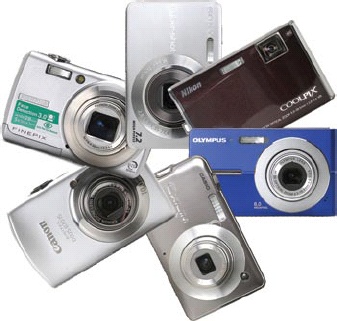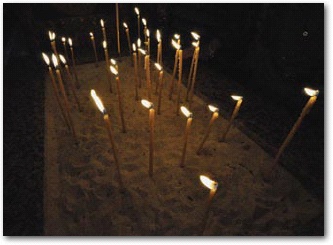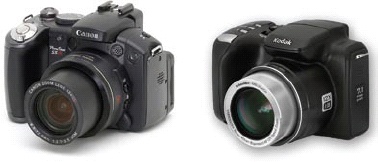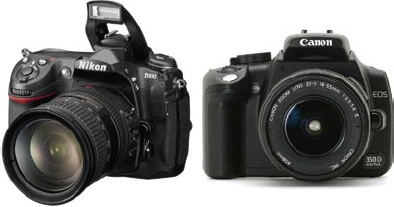Year after year, the digital camera is one of the hottest-selling products on the face of the earth. Every year, 15 million people snap them up, spend $42 billion in the process, and take 50 billion photos with them.
All that popularity is good, because it means the marketplace is crowded. Competition means lower prices, nicer features, and better cameras.
But it's also bad, because all those hundreds of models make camera shopping much more complicated. And not to depress you or anything, but camera companies generally update their lineups twice a year (in October and February). Each generation offers better features, improved resolution, and lower prices. That's right: Whatever camera you buy today will be obsoleteâwell, at least no longer soldâin about six months.
On top of all that, the features and specs that should matter when you shop for a camera usually aren't easy to figure out. (Just try, for example, to find out the sensor size for a camera you're considering; it's not on the box and not in the brochure.) Meanwhile, the camera makers and camera stores often flog features and specs that don't matter at all, like the number of megapixels the camera has. (Yes, that's right. Read Chapter 2 to find out why having a lot of megapixels is irrelevantâor even a bad thing.)
The major players include companies like Canon, Nikon, Sony, Kodak, Panasonic, Olympus, HP, Casio, and Fujifilm. Each company offers a variety of models and a prices to compete for your dollars.
Before you learn how to use a camera, of course, you have to have a camera. This chapter and the next provide an overview of every kind of camera, and every feature on those cameras, accompanied by notes that tell you whether each one is genuinely useful or just marketing blather. May these chapters guide you the next time you're shopping for a digital camera.
Cameras come in an enormous range of sizesâa much bigger variation than you'd find in, say, music players or cellphones. They're so differentiated, they almost constitute different product categories.
The huge majority of peopleâmore than 90 percentâwind up buying those little shirt-pocket cameras, about the size of an iPod or cellphone. There's an overwhelmingly convincing reason for this: If the camera is small, you'll be more likely to have it with you when life's great photo ops arise.
And real life proves them right. You can carry these minicams in your pocket, purse, or glove compartment, or toss one into your carry-on bag for a trip, without adding any real weight or bulk. Even professional photographers, usually laden with 30-pound bags of camera gear, often carry around a pocket cam when they're "off duty," just in case (or as a backup).
Pocket cams usually take perfectly good photos; occasionally, terrific ones. They also take movies, which is a huge advantage (and one that accounts for the slow but steady crashing of the camcorder market). But there's a big difference between usually and always, and there's a huge gulf between perfectly good photos and amazing ones.
Here, for example, are some of the frustrations with pocket cams:
Shutter lag. This is it: the one that drives everybody crazy. Shutter lag is the delay between the time you press the shutter button and the time you get the shot. It's only half a second, or even less, but that delay can make all the difference. In that time, the kid has left the diving board, the expression you wanted is gone, and you've missed the home-run swing.
Technically speaking, shutter lag is the time it takes for the camera to calculate focus and exposure (how bright to make the scene). Little cameras don't sell unless they're inexpensive, so they contain fairly feeble circuitryâslowish chips that take their time doing those calculations.
Tip
There is, of course, a simple way to eliminate shutter lag: Use the half-press technique. It's described on Take the Shot.
Lousy low-light shots. Tiny cameras usually have tiny sensorsâthe small, rectangular light-sensing chips that do what film used to do in the cameras of old. Sensors improve each year; but in general, the smaller the sensor, the worse the photos. Tiny sensors mean that less light is used to capture the image, which means color that isn't as true and, above all, poor performance in low light.
What does that mean? First, blur. To compensate for the tiny sensor, the shutter has to stay open longer to let in more light; during that time, the slightest movement of the camera creates a blurry image. Pocket cameras take a lot of blurry pictures at night, indoors, and indoors at night.
The second problem is noise. "Noise" is the geek term for tiny, grainy, colored speckles that ruin a lot of nighttime photos from small cameras.
To compensate for their lack of light sensitivity, little cameras wind up firing their flashes a lot. Which is fine for snapshots. But the light from the flash, especially the flash on little cameras, tends to be harsh and white and superbright, making even your dearest loved ones look like they've been nuked. It's not a very attractive look.
Limited zoom. The last problem with small cameras is that you're stuck with the lenses that come with them. You can't swap a telephoto lens (good for magnifying distant scenes) with a macro lens (good for extreme closeups).
The camera makers generally give you a good compromise: a general-purpose, basic lens that can magnify a scene by three or four times (that is, it's a 3X or 4X zoom lens). As you'll soon discover, however, that makes small cameras pretty much useless for shooting soccer games, rock concerts, school plays, or anything else where you want to be able to identify individual faces in the resulting pictures.
As you can see, pocket cameras have their limits. They'll disappoint you now and then, especially in low light and when you're far from the action.
Fortunately, the other 80 percent of the time, you wind up very happy with your picturesâespecially because you had the camera with you.
If you're willing to put up with a little more bulk, you can move up to a midsize camera whose chief advantage is a powerful zoom. It's not unusual for these models to offer 12X, 15X, or even 20X zoom powers, which ought to solve your soccer game/rock concert/school play dilemma quite nicely.
Why is a powerful zoom such a big deal? Because so many of life's great photographic moments happen at a distance: on a stage (school play, graduation ceremony, dance recital, wedding), a playing field (soccer, baseball), or some other kind of field (lion, elephant, buff-breasted pipit).
Midsize cameras also have room for another disappearing luxury: an eyepiece viewfinder, which comes in handy when the sun washes out the back-panel screen. These models, however, employ electronic viewfindersâthat is, a tiny video screen inside the eyepiece, rather than a clear piece of glass. It shows exactly what you're about to shoot, but the image isn't as clear, nuanced, or smooth as a see-through viewfinder.
Most of them have flip-out screens, too, so you can shoot around corners, over people's heads, and down low at baby level without stooping. More on this topic in Chapter 2.
The downside is that, apart from the superzoom lens, these cameras aren't any better than shirt-pocket cameras, photographically speaking. The sensor inside is still pretty tiny.
Outdoors, or wherever there's copious light, these cameras take terrific, clear shots with vivid colors. But indoors and after dinnertime, it's another story. You'll probably have to throw out a significant number of your indoor, no-flash photos, which are often victims of horrible graininess or blur.
Furthermore, these cameras are generally squat and bulkyâno pants pocket for you, palâso you pretty much have to carry yours around over your shoulder or in a camera bag. And if you're going to endure that, then you may as well consider a full-blown SLR, described next.
You may be perfectly satisfied with the snapshots taken by your sleek, slim, silver shirt-pocket digital camera. But then you see pictures in magazines that you just know were taken with better equipment. You know: razor-sharp portraits with softly blurred backgrounds. Car taillights drawing bright orange tracks across the nighttime frame. A waterfall, smoothed by a slow shutter into a silky veil. Or just about anything that happens fast.
Shots like these are child's play, however, for a digital SLR. (SLR stands for "single-lens reflex," which obviously doesn't make the term any clearer. But the basic idea is that you're looking out through the lens when you hold the eyepiece viewfinder to your eye.)
These big, black, interchangeable-lens cameras won't fit in your pocket, unless you're a kangaroo. And they scream, "I'm a tourist" when they're hanging from your neck.
But their photos blow those little shirt-pocket cams out of the water. They're photographically superior in every regard. They turn on instantly; take stunning, magazine-quality photos; have zero shutter lag; can fire three shots a second; offer infinite manual control (white balance, exposure, and so on); and go for days or weeks on a battery charge. (A pocket camera manages about 300 shots per battery charge. An SLR might take 2,500.)
These cameras make you understand why people get hooked on photography. It starts with the feel of the huge, rugged body in your hands, a shape that's been refined over the decades. It continues with the satisfying, instantaneous click of the shutterânot a chirpy audio recording from a speaker, but the actual clack of the SLR's mirror snapping out of the way.
You may be perfectly happy with the starter lens that comes in the box. Even so, you can rest easy, knowing that if you ever need it, a catalog of additional lenses awaits. You can pop on a fish-eye lens and snap a complete 180-degree vista in a single photo. Or just get a wide-angle lens for shooting room interiors or landscapes without the rounded-cornered look of fish-eye photos.
With a macro lens, you can shoot a bumblebee or a splinter, huge and clear as though it were in National Geographic. Or snap on a huge telephoto lens and sit in the bleachers at a tennis tournament, snapping hyper-closeups of the players' sweaty faces.
You can read more about SLRsâand lensesâin Chapter 7.
Tip
Yes, lenses are expensiveâsome cost more than the camera. But keep in mind that you can also rent them, either from camera shops or from a Web-based company like www.lensprotogo.com.
Get David Pogue's Digital Photography: The Missing Manual now with the O’Reilly learning platform.
O’Reilly members experience books, live events, courses curated by job role, and more from O’Reilly and nearly 200 top publishers.





